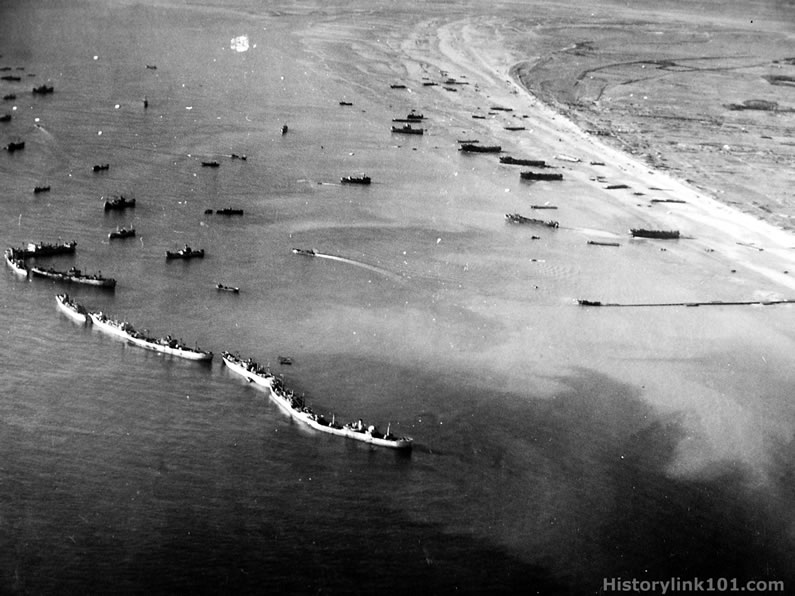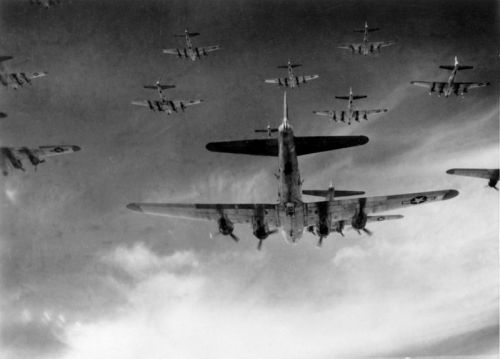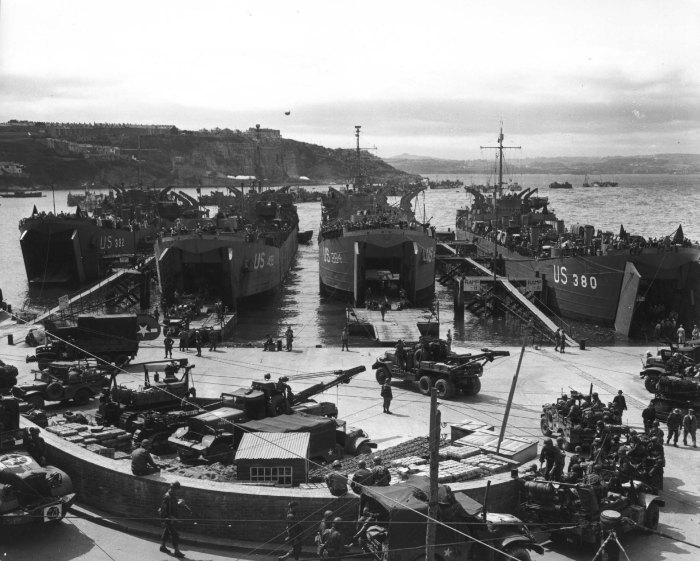
Posted on 06/06/2014 6:49:32 PM PDT by LibertyGirl14
A couple of years ago, I wrote a piece about the fading sentimental connection of today’s generations with World War II, the defining event of the 20th century. There is some oddity in living through the transition: in seeing the soldiers whom FDR called “our sons” become our grandfathers and great-grandfathers, and then the ghosts of history commemorated on tombstones.
One of the most important transitions is the fading of the grand narrative by which we defined and guided our nation for so many decades. The hindsight of history has its rewards. But it has its drawbacks as well, as immediacy and personal connection disappear behind us...




Well then, a whole bunch of Allied ships and planes descended upon the place and proceeded to unload a large amount of troops, material and other things.
This was before there were smartphones, tablets and iPods.

US Army Air Corps B-17s were part of the strategic air campaign to isolate the German beach defenses

The story of how this was all brought together is stunning..and that without smart phones etc....truly an amazing feat beyond the scope of what we can imagine....
Great pics, caww. Thanks so much for posting.
Just finished watching D-Day in HD premiere on History Channel. Lots of previously unseen footage...much in color.

I am enjoying this as I can view each picture closely....remarkable what these great hero’s accomplished....stunning really!


The landing beaches at OMAHA stretched about 6500 meters from Colleville-Sur-Mer to Vierville-Sur-Mere in the west. The beaches are wide with bluffs overlooking them and a seawall between the beaches and the bluffs. Additionally several small towns dot the beach. To the west of the town of Vierville, a prominent height overlooked the entire beachhead. Named Pont du Hoc, it was believed to house a 150mm battery sighted where it could enfilade the OMAHA landing zones.
The Americans assigned to the 2nd Ranger Battalion to make a seaborne assault to land, scale the cliffs and take the battery. Companies from this battalion made a heroic landing and scaled the cliffs to capture the strongpoint only to discover that the guns had not been emplaced. The Rangers took heavy casualties and held their isolated beachhead against German counterattacks until relieved by the 29th Division on the morning of June 8th.


As the soldiers of the American divisions on OMAHA came ashore they faced German defenders of the 352nd, 716th and a regiment of the 709th Infantry Division, the latter under the tactical command of the 352nd. Without the bulk of their tanks artillery and lacking close air support the Americans struggled across the beaches and were cut down in large numbers before being pinned down behind the sea wall.
With the Americans pinned down on the beach unable to advance, the time tables for the reinforcing waves became snarled amid the German beach obstacles which had not been cleared.... This was in large part due to 40% casualties among the Combat Engineers and the loss of all but five bulldozers.
Naval officers were frustrated in their attempts to provide naval gunfire support by the lack of identifiable targets on the beaches. Yet German strongpoint’s were “knocked out by either by superbly directed vigorous gunfire from destroyers steaming as close as 800 yards offshore, or by determined action from Rangers or infantry


Stunning is right....considering they had virtually NO communications. Gen Bradley was so desperate for info, that he sent one of his P boats over to the next beach to get intel. The news was not good, either.
Under their leadership small units from the 116th which had its linage back to the “Stonewall Brigade” as well as elements of the 16th and 18th Infantry Regiments began to move forward..... Surviving junior leaders began to lead survivors through the dunes and up the bluffs to attack German defenders of the roads leading up from the beach from the flank and rear. A mid-day break in the weather allowed some close tactical air support giving the troops badly needed support.
US 1st Infantry Division Troops at the Omaha sea wall

These did not work as planned. The rough seas deflated them and many of them sank.
It’s really quite overwhelming when you consider all they faced and how the operations ultimately were successful when all was said and done...but the loses were great...even so where would we be today had they not made these great sacrifices...thanks is hardly enough...
I understood that they didn’t work as planned...but there was also some resistance by US leaders in taking them in the first place.... there was also a great deal of sea sickness from the waves so many came on shore ill to begin with...shoving that aside they moved forward just the same.
Disclaimer: Opinions posted on Free Republic are those of the individual posters and do not necessarily represent the opinion of Free Republic or its management. All materials posted herein are protected by copyright law and the exemption for fair use of copyrighted works.